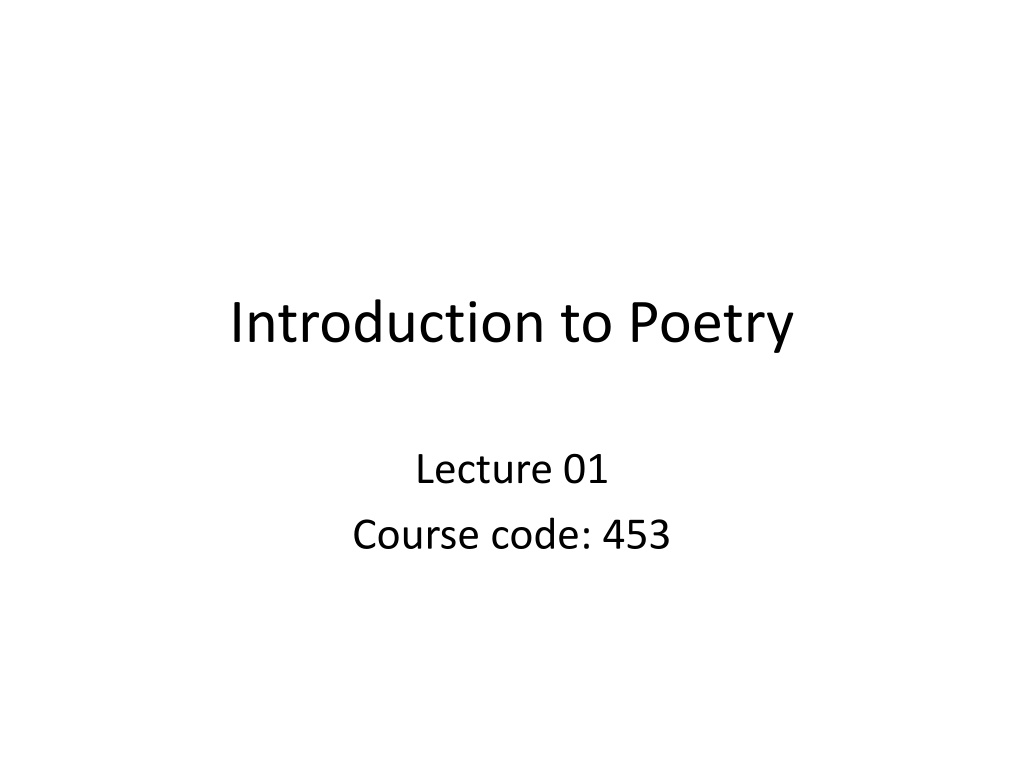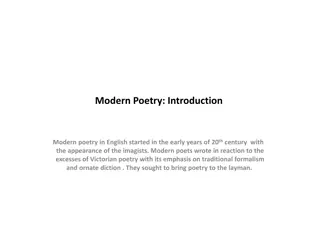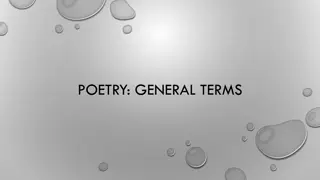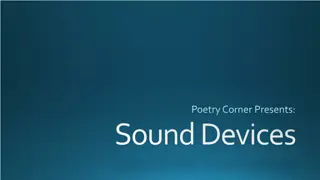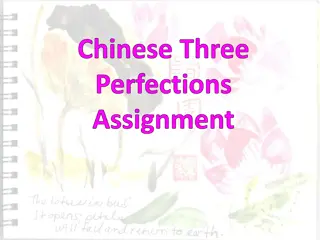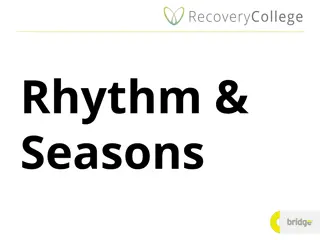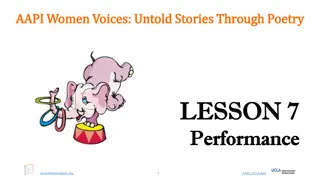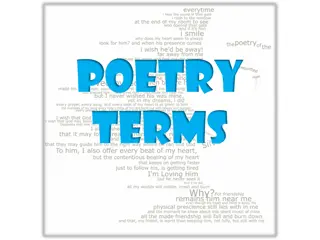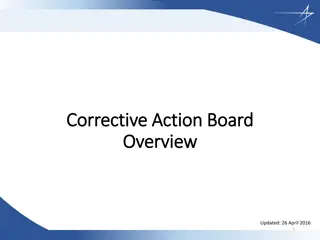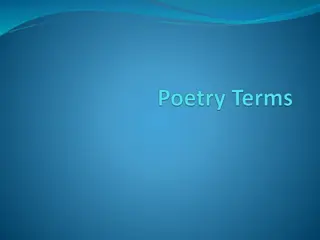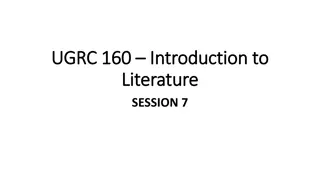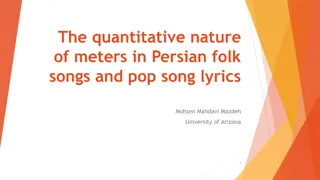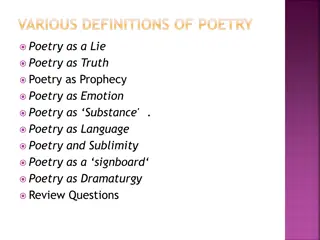Poetry: Forms, Devices, and Rhythms
Poetry utilizes various forms, devices, and rhythms to evoke emotions and convey multiple layers of meaning. Poetic devices such as rhyme, rhythm, metaphor, and simile play a crucial role in creating musicality and depth in poems. Understanding the organization of speech rhythms, accent patterns, and metrical units is essential to distinguishing poetry from prose. Explore the world of poetry through the exploration of these fundamental elements.
Uploaded on Sep 28, 2024 | 0 Views
Download Presentation

Please find below an Image/Link to download the presentation.
The content on the website is provided AS IS for your information and personal use only. It may not be sold, licensed, or shared on other websites without obtaining consent from the author.If you encounter any issues during the download, it is possible that the publisher has removed the file from their server.
You are allowed to download the files provided on this website for personal or commercial use, subject to the condition that they are used lawfully. All files are the property of their respective owners.
The content on the website is provided AS IS for your information and personal use only. It may not be sold, licensed, or shared on other websites without obtaining consent from the author.
E N D
Presentation Transcript
Introduction to Poetry Lecture 01 Course code: 453
Poetry & Poetic Devices Poetry uses forms and conventions to suggest differential interpretation to words, or to evoke emotive responses. Devices such as assonance, alliteration, onomatopoeia and rhythm are sometimes used to achieve musical or incantatory effects. The use of ambiguity, symbolism, irony and other stylistic elements of poetic diction often leaves a poem open to multiple interpretations.
Similarly, metaphor, and simile create a resonance between otherwise disparate images a layering of meanings, forming connections previously not perceived.
Rhyme This is the one device most commonly associated with poetry by the general public. Words that have different beginning sounds but whose endings sound alike, including the final vowel sound and everything following it, are said to rhyme. Example: time, slime, mime
Rhythm The organization of speech rhythms (verbal stresses) into a regular pattern of accented syllables separated by unaccented syllables. Rhythm helps to distinguish poetry from prose. Example: i THOUGHT i SAW a PUSsyCAT. Such patterns are sometimes referred to as meter. Meter is the organization of voice patterns, in terms of both the arrangement of stresses and their frequency of repetition per line of verse.
Rhythm Poetry is organized by the division of each line into feet, metric units which each consist of a particular arrangement of strong and weak stresses. The most common metric unit is the iambic, in which an unstressed syllable is followed by a stressed one (as in the words reverse and compose).
Rhythm There are five basic rhythms: Pattern Name/ Example / Iamb/Iambic invite / Trochee/Trochaic deadline / Anapest/Anapestic to the beach / Dactyl/Dactylic frequently / / Spondee/Spondaic true blue
Meter Meter is measured by the number of feet in a line. line with five feet is called pentameter; thus, a line of five iambs is known as iambic pentameter (the most common metrical form in English poetry, and the one favored by Shakespeare). The most common line lengths are: monometer: one foot
Meter dimeter: two feet Trimeter: three feet tetrameter: four feet pentameter: five feet hexameter: six feet heptameter: seven feet octameter: eight feet
Imagery The use of vivid language to generate ideas and/or evoke mental images, not only of the visual sense, but of sensation and emotion as well. While most commonly used in reference to figurative language, imagery can apply to any component of a poem that evoke sensory experience and emotional response, and also applies to the concrete things so brought to mind.
Imagery The poet s carefully described impressions of sight, sound, smell, taste and touch can be transferred to the thoughtful reader through imaginative use and combinations of diction. In addition to its more tangible initial impact, effective imagery has the potential to tap the inner wisdom of the reader to arouse meditative and inspirational responses.
Imagery Examples: Sight: Smoke mysteriously puffed out from the clown s ears. Sound: Tom placed his ear tightly against the wall; he could hear a faint but distinct thump thump thump. Touch: The burlap wall covering scraped against the little boy s cheek. Taste: A salty tear ran across onto her lips. Smell: Cinnamon! That s what wafted into his nostrils.
Tone & Mood The means by which a poet reveals attitudes and feelings, in the style of language or expression of thought used to develop the subject. Certain tones include not only irony and satire, but may be loving, condescending, bitter, pitying, fanciful, solemn, and a host of other emotions and attitudes.
Tone Tone can also refer to the overall mood of the poem itself, in the sense of a pervading atmosphere intended to influence the readers emotional response and foster expectations of the conclusion. Another use of tone is in reference to pitch or to the demeanor of a speaker as interpreted through inflections of the voice; in poetry, this is conveyed through the use of connotation, diction, figures of speech, rhythm and other elements of poetic construction.
Rousseau s Beliefs Held that society corrupts man. Material progress (in arts and science) have not been beneficial but resulted in negative traits e.g. vanity, pride, greed etc. Believed that sovereignty should be in the hands of the people: Man is born free and everywhere he is in chains Such views challenged old ideas of political domination & social injustices and heralded change.
Preface to Lyrical Ballads by Wordsworth: a turning toward a more experimental, more emotional lyricism Emphasis on natural and rustic themes in poetry, humble and rustic life was generally chosen, because, in the condition, the essential passions of the heart find a better soil in which they can attain maturity, are less under restraint, and speak a plainer and more emphatic language, because in that condition of life our elementary feelings co-exist in a state of greater simplicity. About poetry, he says Poetry is the spontaneous overflow of powerful feelings: it takes its origin from emotion recollected in tranquility, & Poetry is the outcome of a creative process .Pleasure is the state in which the poetic composition is written, and pleasure is also found in the result.
Preface. About language of poetry he says, My purpose was to imitate, and, as far as possible to adopt the very language of men; and assuredly such personifications do not make any natural or regular part of that language. About Poet, What is a Poet?...He is a man speaking to men: a man, it is true, endued with more lively sensibility, more enthusiasm and tenderness, who has a greater knowledge of human nature, and a more comprehensive soul, than are supposed to be common among mankind. New role for the Poet, the poet s main qualifications are not in matters of craft or technique; he is a poet because his feelings allow him to enter sympathetically into the lives of others and to translate passions into words that please.
Factors leading to Romantic Movement: Romantic Movement as a Reaction 1) Reaction to changes in society e.g. Industrialization destruction of natural beauty and peace, caused an uncontrolled growth of the city. Small towns called mushroom towns were constructed for the workers. Also cottage industry was destroyed and movement of people to cities. Urbanization poor living conditions in cities for workers; living in the city meant long working hours and appalling living conditions. Industrial cities lacked elementary public services (water supply, sanitation, street-cleaning, open spaces). Materialism increase in greed and vanity, rise of middle class
As a Reaction.. 2) Reaction against rigid social structures in societies, French Revolution (1789) : overthrow of monarchy and establishment of republic form of government. American War of Independence (1775-1783) : American colonies establishing freedom from British rule. emphasized natural rights , and freedom of individual (Rousseau) whole idea of nationalism changed, and so did the romantic view; it consisted then in self-determination and a pride in the national origins
3) Reaction to Enlightenment Revolt against the literary and artistic traditions of the 18thC Classicism Romanticism now becomes evil and corrupt. now nature overwhelms the character now dynamic, fantastical and subjective Society : believed to be good, curbing violent tempers Characters : ideal and eternal, world : ideal, static, objective world;
Reaction to Enlightenment. Classicism artist : simple observer of nature; emphasis on rationality and logic; hero : dominated by moral character; Romanticism now he is interpreter of nature, supreme being. now emphasis on sentiments and passion. now sentimental hero constantly in search of absolute Simple diction is used Artistic language and style were emphasized
Characteristics of Romanticism Imagination : The imagination was elevated to a position as the supreme faculty of the mind. The Romantics tended to define and to present the imagination as our ultimate "shaping" or creative power; it was the approximate human equivalent of the creative powers of nature or even deity. It is dynamic, an active, rather than passive power, with many functions. Imagination is the primary faculty for creating all art. Poet s capacity of imagination differentiated him from the ordinary.
Characteristics. Imagination is extolled as the ultimate synthesizing faculty, enabling humans to reconcile differences and opposites in the world of appearance. The reconciliation of opposites is a central ideal for the Romantics. Blake : One Power alone makes a poet; Imagination, the divine vision. Coleridge : it is the supreme poetic faculty.
Characteristics. Love of Nature The Romantics greatly emphasized the importance of nature and the primal feelings of awe, apprehension and horror felt by man on approaching the sublime nature. Nature was not only appreciated for its visual beauty, but also revered for its ability to help the urban man find his true identity. Importance was given to accurate observation & description of wild Nature which serves as stimulus to Thinking and to the resolution of personal problems and crisis. Closeness to Nature was seen as bringing out humanity s innate goodness.
Characteristics. Nature Nature meant many things to the Romantics - nature as a healing power, nature as a source of subject and image, nature as a refuge from the artificial constructs of civilization, including artificial language, as a spirit etc. Romantics gave greater attention both to describing natural phenomena accurately and to capturing "sensuous nuance Romantic nature poetry is essentially a poetry of meditation. Romantic poets take inspiration from natural world and rejoice in its beauty.
Characteristics. Symbolism and Myth Symbols were valued because they could simultaneously suggest many things. It may also have been the desire to express the "inexpressible"-- the infinite--through the available resources of language that led to symbol at one level and myth (as symbolic narrative) at another. Most often the intense feelings were described using symbols.
Characteristics. Individualism The Romantics asserted the importance of the individual, the unique, even the eccentric. They preferred the outclass, and the rebel; theme of exile was common. It was in fact Shelley's opinion that Satan, in his noble defiance, was the real hero of Milton's Paradise Lost. There was a great belief in democratic ideals, concern for human liberty & outcry against different forms of tyranny. Human was seen as creating the world and having access to the infinite via the faculty of imagination. This refusal to accept limitation found expression in bold poetic experimentation.
Characteristics. The Everyday and the Exotic The romantics turned to contemporary country such as folk legends and older, "unsophisticated" art forms, such as the ballad, and to contemporary country folk who used "the language of common men," not an artificial "poetic diction The Romantics were also fascinated with the exotic. Often, both the everyday and the exotic appeared together in paradoxical combinations. In the Lyrical Ballads, for example, Wordsworth and Coleridge agreed to divide their labors according to two subject areas, the natural and the supernatural. There was renewed interest in the Middle Ages (esp. the ballad form) as a beautiful, exotic, mysterious by-gone period.
Characteristics. The Romantic Artist in Society the Romantics were ambivalent toward the "real" social world around them. They were often politically and socially involved, but at the same time they began to distance themselves from the public. Romantic artists interpreted things through their own emotions, and these emotions included social and political consciousness--as one would expect in a period of revolution, one that reacted so strongly to oppression and injustice in the world.
Characteristics. They withdrew more and more from what they saw as the confining boundaries of bourgeois life. Yet a significant Romantic theme became the contrast between artist and middle-class "Philistine. (term used by Mathew Arnold to refer to the middle class)
Characteristics. Lyric Poetry, and the Self Wordsworth's definition of all good poetry as "the spontaneous overflow of powerful feelings" marks a turning point in literary history. By locating the ultimate source of poetry in the individual artist, the tradition, stretching back to the ancients, of valuing art primarily for its ability to imitate human life (that is, for its mimetic qualities) was reversed. This led to a prominence for first-person lyric poetry never accorded in any previous period. The "poetic speaker" became less a persona (someone speaking on behalf of the poet) and more the direct person of the poet (voice of the poet).
Characteristics. Emotions Vs. Rationality Romanticism placed human emotions, feelings, instinct and intuition above everything else. While the poets in the era of rationality adhered to the prevalent rules and regulations while selecting a subject and writing about it, the Romantic writers trusted their emotions and feelings to create poetry. This belief can be confirmed from the definition of poetry by William Wordsworth, where he says that poetry is the spontaneous overflow of powerful feelings.
Characteristics. Nationalism the Romantics became interested and focused upon developing the folklore, culture, language, customs and traditions of their own country, they developed a sense of Nationalism which reflected in their works. Also, the language used in Romantic poems was simple and easy to understand by the masses.
Characteristics. Supernatural The Romantics were interested in the supernatural and included it in their works. Gothic fiction emerged as a branch of Romanticism after Horace Walpole's 1764 novel The Castle of Otranto. This fascination for the mysterious and the unreal also led to the development of Gothic romance, which became popular during this period. Supernatural elements can also be seen in Coleridge's Kubla Khan', The Rime of the Ancient Mariner and Keats' La Belle Dame Sans Merci.
Romantic Poets First Generation Romantic Poets William Blake, William Wordsworth, & Samuel T. Coleridge Second Generation Romantic Poets Lord Byron, P.B. Shelley, & John Keats
William Blake To see a World in a Grain of Sand And a Heaven in a Wild Flower, Hold Infinity in the palm of your hand And Eternity in an hour. William Blake Blake s life was spent in rebellion against the restrictive influences of institutions such as government and the church. Blake was aware of the negative effects of the rapidly developing industrial and commercial society. Blake wrote two books: Songs of Innocence and Songs of Experience . In The Lamb from the Songs of Innocence Blake presented with an image of a gentle, benevolent, loving God. In The Tyger from Songs of Experience, God is vindictive and terrifying.
William Blake : life William Blake was born in London, where he spent most of his life. Blake was first educated at home, chiefly by his mother. His parents encouraged him to collect prints of the Italian masters, and in 1767 sent him to Henry Pars' drawing school. From his early years, he experienced visions of angels and ghostly monks, he saw and conversed with the angel Gabriel, the Virgin Mary, and various historical figures. Independent through his life, Blake left no debts at his death on August 12, 1827. He was buried in an unmarked grave at the public cemetery of Bunhill Fields.
William Wordsworth : Nature never did betray The heart that loved her. William Wordsworth s poetry emphasizes the value of childhood experience and the celebration of nature. He glorifies the spirit of man, living in harmony with his natural environment, far from the spiritual bankruptcy of city life. Pantheistic, identified nature with god. Wordsworth is best known as a nature poet who found beauty, comfort and moral strength in the natural world. For him the World of nature is free from corruption and stress, and offers man a means of escape from industrialized society.
William Wordsworth : life William Wordsworth was born on April 7, 1770, at Cockermouth on the River Derwent, in the heart of the Lake District that would come to be immortalized in his poetry. The son of a lawyer named John Wordsworth, he was the second of five children. His father was the personal attorney of Sir James Lowther, Earl of Lonsdale, the most powerful (and perhaps the most hated) man in the area. Wordsworth died on April 13, 1850.
S. T. Coleridge : The Nightmare Life-in-Death was she, Who thicks man's blood with cold. Samuel T. Coleridge s poetry often deals with the mysterious, the supernatural and the extraordinary. While Wordsworth looked for the spiritual in everyday subjects, Coleridge wanted to give the supernatural coloring of everyday reality. In The Rime of Ancient Mariner Coleridge describes the natural and supernatural events that occur during the adventurous voyage. The events of the poem take place in an eerie, ghostly atmosphere and the reader often feels he is moving from a real to an unreal world and back again.
Samuel Taylor Coleridge : life Samuel Taylor Coleridge was born in Ottery St Mary, Devonshire, as the youngest son of the vicar of Ottery St Mary. After his father's death Coleridge was sent away to Christ's Hospital School in London. He also studied at Jesus College. In Cambridge Coleridge met the radical, future poet laureate Robert Southey. After 1817 Coleridge devoted himself to theological and politico- sociological works. Coleridge was elected a fellow of the Royal Society of Literature in 1824. He died in Highgate, near London on July 25, 1834. He had a close friendship with Dorothy and William Wordsworth, one of the most fruitful creative relationships in English literature. From it resulted Lyrical Ballads, which opened with Coleridge's "Rime of the Ancient Mariner" and ended with Wordsworth's "Tintern Abbey".
Byron : Man's love is of man's life a thing apart, 'Tis woman's whole existence. George Byron was the prototype of the Romantic poet. He was heavily involved with contemporary social issues. He like the heroes of his long narrative poems, was a melancholy and solitary figure whose actions often defied social conventions.
Shelley : If winter comes, can Spring be far behind Percy Bysshe Shelley was the most revolutionary and non-conformist of the Romantic poet. He was an individualist and idealist who rejected the institutions of family, church, marriage and the Christian faith and rebelled against all forms of tyranny.
Keats : Beauty is Truth, and Truth Beauty That is all ye know on earth & all ye need to know John Keats s life makes his literary achievements even more astonishing. The main themes of his poetry are: the conflict between the real world of suffering, death and decay and the ideal world of beauty, imagination and eternal youth.
